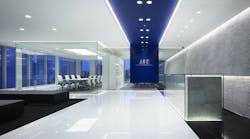The goal of the study was to identify solutions to reduce maintenance and energy use without compromising the quantity or quality of existing illumination.
However, the historic status and high efficacy of the existing luminaires – as well as their color characteristics, which are accepted by roadway users – will present challenges for energy-saving alternatives.
The study was carried out by the US Department of Energy (DOE) Gateway demonstration program, with support from the Golden Gate Bridge Highway & Transportation District and Pacific Gas & Electric.
Four luminaire types containing HPS or LPS lamps are currently used to illuminate the roadway, the two walkways, and the two towers. Various replacement options were evaluated, including custom LED retrofit kits, as well as fully-integrated LED or ceramic-metal halide (CMH) luminaires.
No suitable commercially-available LED retrofit kits were identified that would be suitable for installation within existing luminaire housings. However, it appears feasible to develop custom LED retrofit kits which would save energy while maintaining light levels. In doing so, issues surrounding color and color shift, thermal effects, vibration, and product weight may need to be addressed.
Light emitted by existing luminaires is more yellow in appearance than light emitted by the alternative technologies, so mock-ups should be considered to determine whether a whiter light would be appropriate. Also, preliminary analysis suggests that many of the alternative sources may appear somewhat greenish when installed in one of the existing luminaire types, which is an amber-lensed shoebox.
Several fully-integrated LED and CMH luminaires were found to offer energy savings, although the CMH products might increase maintenance due to the shorter rated lamp life. Alternately, it might be possible to reformulate the amber lenses to allow the use of off-the-shelf LED or CMH products.
This analysis assumed that existing light levels must be preserved. Alternatively, if reduced illumination was found to be acceptable, this could enable the use of lower-wattage products. In turn this would increase energy savings and improve the feasibility of using LED technology in this application.




